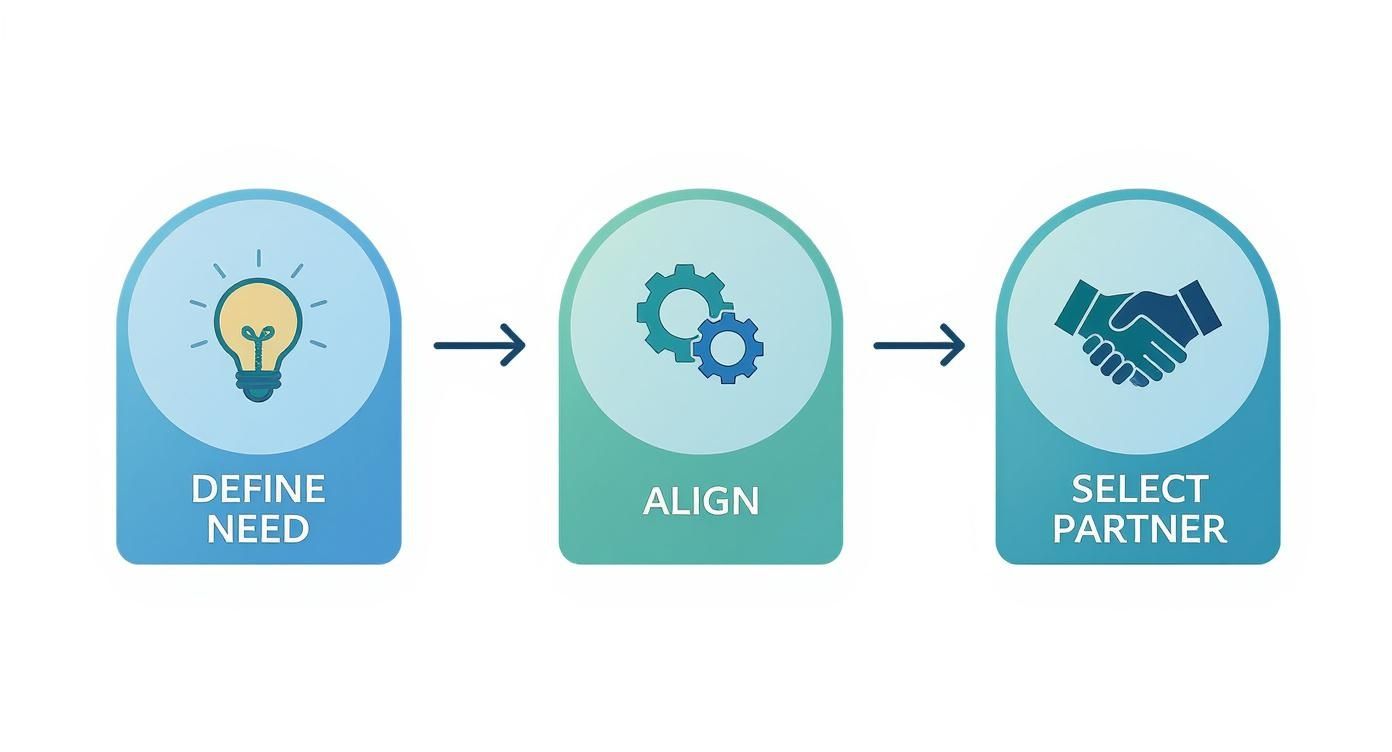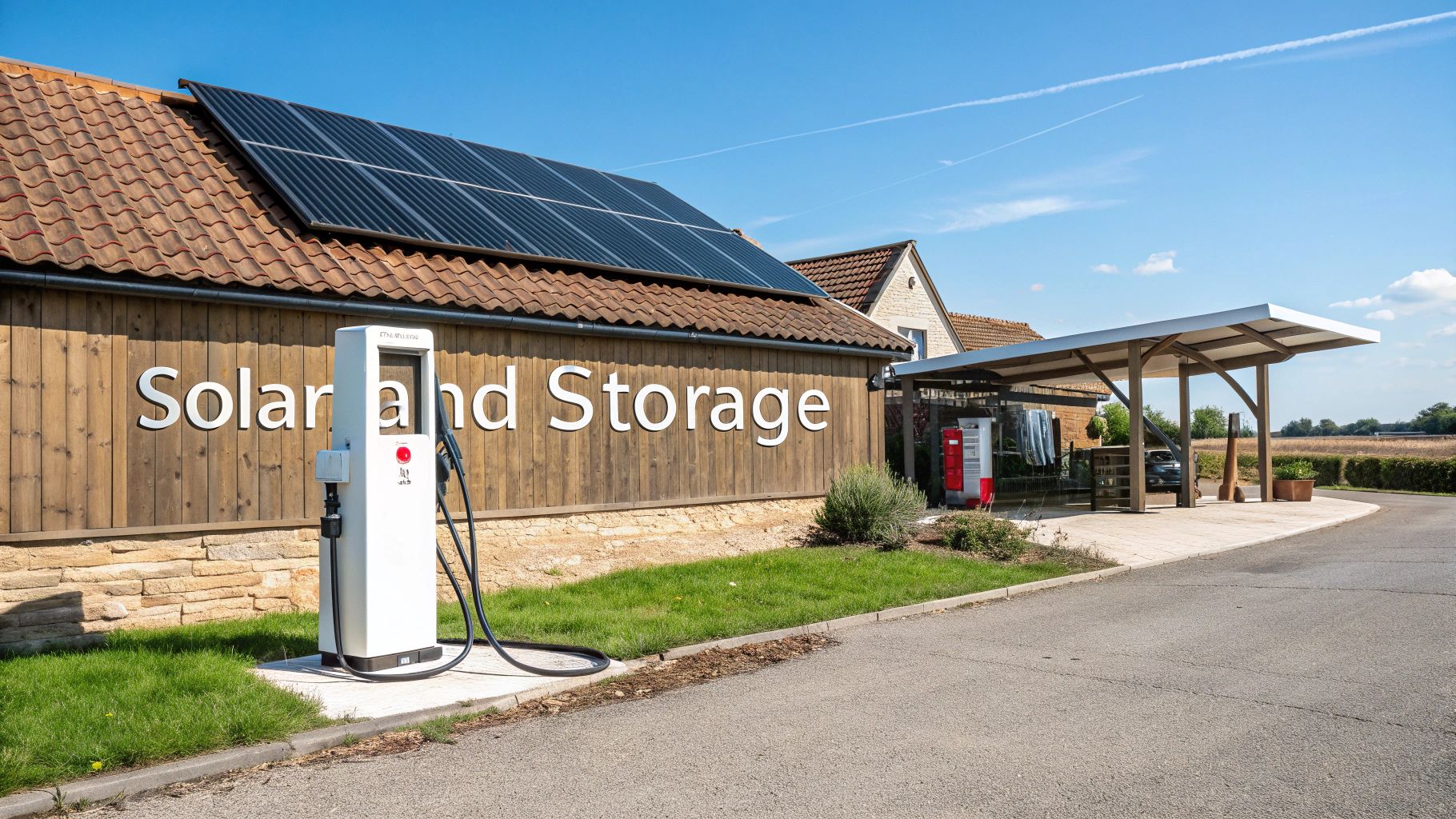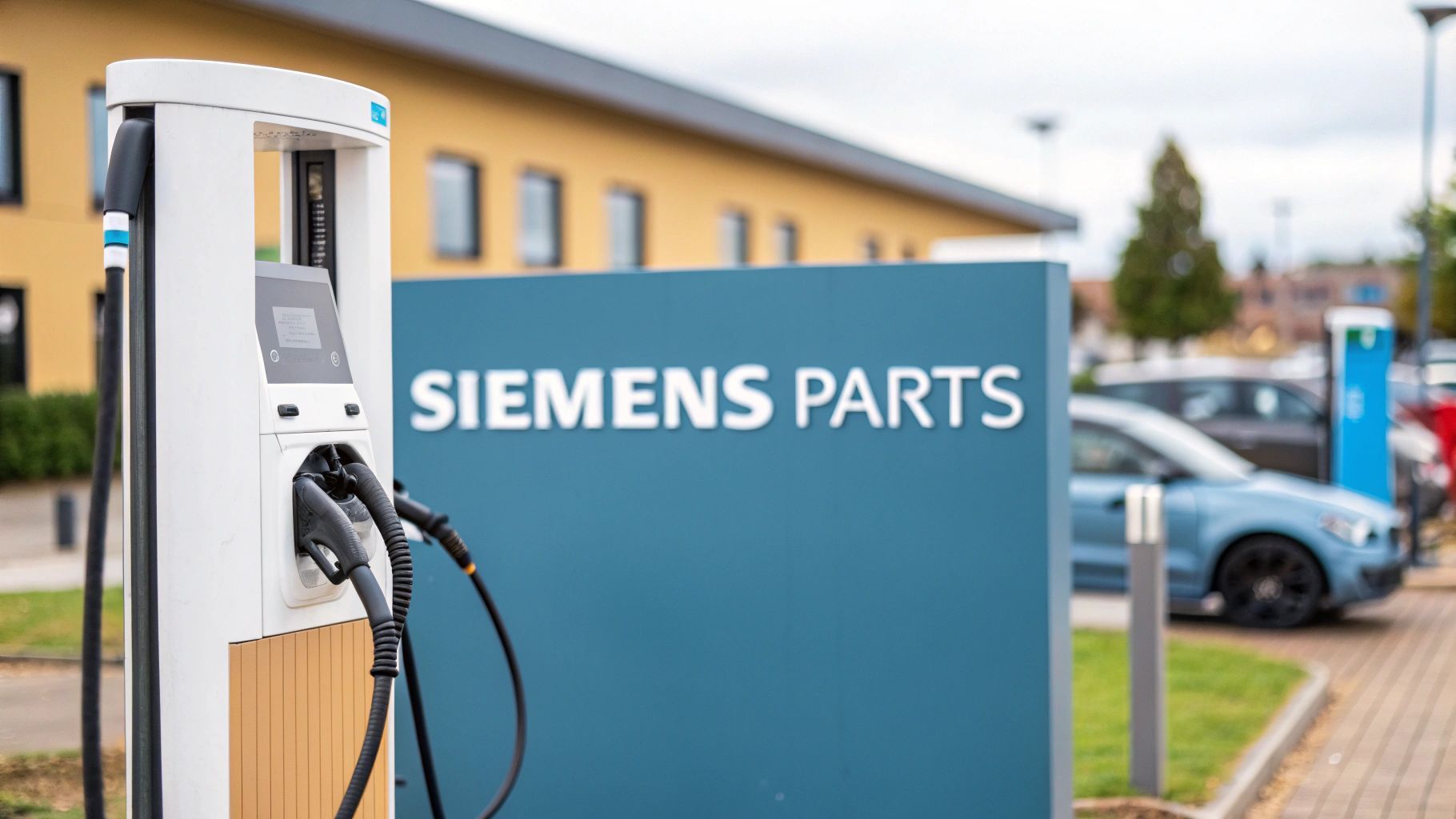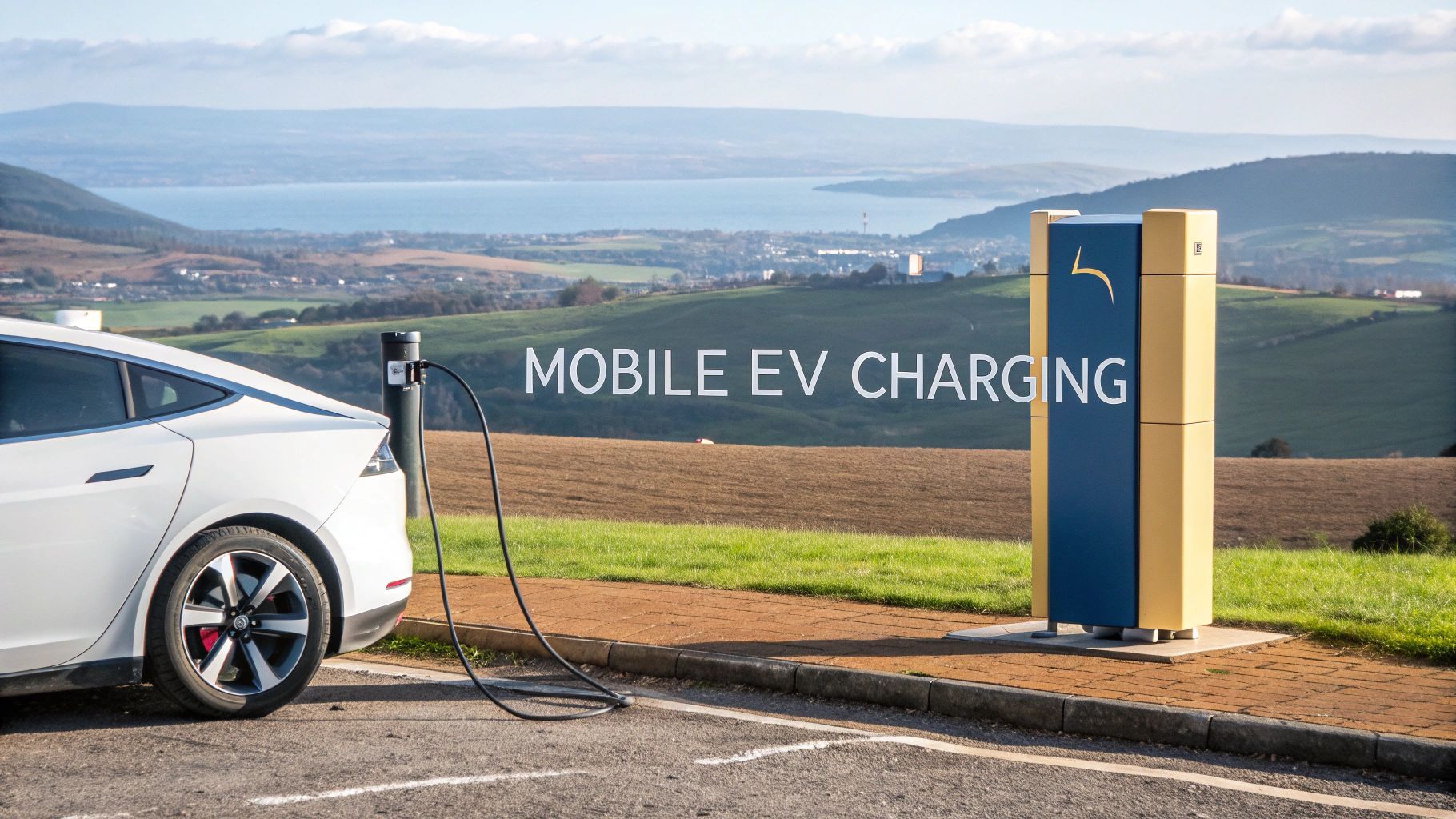Choosing EV Chargers Manufacturers in the UK
Choosing the right EV chargers manufacturers is not just a purchase; it is a foundational infrastructure decision for any UK business. This choice sets the course for your future energy strategy and the experience you offer customers. It is less about simply picking hardware and more about finding a long-term partner whose expertise aligns perfectly with your goals.
Decoding the UK EV Charger Manufacturer Market
The first thing to realise is that choosing a manufacturer is less about big brand names and more about matching your specific needs to their core strengths. The market is incredibly diverse. Some companies excel at building the ultra-rapid chargers you see at motorway service areas but others provide deeply integrated systems that bring together mobile EV charging, grid-scale batteries and on-site renewables like solar.
So, where do you start? Begin by defining your primary objective. Are you electrifying a commercial fleet that needs reliable overnight charging? Are you a retailer looking to offer EV charging as a customer perk? Or perhaps you are a property developer aiming to build a new revenue stream from a public charging hub. Answering this question is the first step to clarifying the type of partner you really need.
Aligning Your Needs with Manufacturer Expertise
Let us walk through a real-world scenario. A retail park developer wants to build a new charging hub. They have two goals: attract EV-driving shoppers with reliable charging and generate a healthy income. This plan immediately rules out manufacturers who only offer slower, domestic-style units.
Instead, they need a partner who specialises in rapid DC charging, robust payment systems and intelligent energy management to cope with high usage and peak demand. Their search should zero in on manufacturers who truly understand commercial operations, not just hardware sales.
This example shows why asking the right questions from the get-go is so important. Do not ask, "Who makes the best charger?" A much more strategic question is, "Which manufacturer provides the best solution for a high-turnover retail environment with a constrained grid connection?" This reframes the entire process from a simple product purchase to a strategic partnership.
The UK's charging landscape is expanding at a blistering pace to meet this demand. The market was estimated at 64,360 units in 2025 and is projected to hit approximately 169,150 units by 2030 . This growth is driven by major players like ABB Ltd, Siemens AG and Tesla Inc., who are all scaling up to meet government targets. We are seeing huge investment shaping the industry, like BP Plc establishing a hub capable of charging 180 vehicles at once.
To help you match your needs with the right supplier profile, here is a quick breakdown of what different types of manufacturers offer.
Key Manufacturer Specialisations at a Glance
| Manufacturer Type | Primary Focus | Ideal Business Application | Example Scenario |
|---|---|---|---|
| Hardware-Centric | Mass production of reliable, standardised AC and DC chargers. | Businesses needing straightforward, plug-and-play charging stations without complex energy management. | A small office adding a few chargers for employee use. |
| Software & Network | Smart charging platforms, payment processing and driver-facing apps. | Organisations wanting to manage a network of public or private chargers and create revenue. | A hotel chain installing chargers across multiple locations. |
| Integrated Energy | Holistic solutions combining chargers with battery storage, solar and grid services. | Sites with high power demands or limited grid capacity, aiming for energy resilience and cost savings. | A logistics depot electrifying its entire HGV fleet. |
| Niche Specialists | Chargers for specific use cases like heavy-duty vehicles, marine or temporary event charging. | Industries with unique requirements that standard chargers cannot meet. | A construction company needing a mobile charging solution for on-site machinery. |
As you can see, the "best" manufacturer is entirely dependent on what your business is trying to achieve.
This visual guide breaks down the process into three clear stages.

The flowchart maps out a logical path: start by defining your internal requirements, then align them with a manufacturer's core capabilities before making a final decision.
The most successful EV charging projects begin with a deep understanding of the business's unique energy profile and operational demands. A manufacturer that offers integrated solutions, including grid-scale batteries and distributed energy management, provides a more resilient and future-proofed investment.
To make an informed decision, you have to understand the broader energy context. You can explore our guide on the key trends reshaping the energy and electric vehicle landscape in 2025 for deeper insights. By looking beyond the charger itself to the entire energy ecosystem, you can select a partner that will support your business's growth for years to come.
Matching Technical Specs to Your Business Needs
Choosing a manufacturer is less about their marketing and more about matching their hardware to your specific operational goals. You need to cut through the jargon because the right specifications will either empower your business or hold it back. The difference between a 7kW AC charger and a 150kW+ DC unit is not just speed; it is about the entire use case.
AC chargers are a perfect fit for places where vehicles sit for hours—think overnight fleet depots or employee car parks. In contrast, rapid DC units are non-negotiable for public-facing businesses like service stations and retail hubs where quick turnaround is everything. Getting this basic distinction right is the first step in your technical assessment.
Decoding Charger Power and Speed
For most commercial applications, the conversation has moved firmly towards rapid EV charging . Manufacturers are pushing the limits, with some units capable of delivering 350kW or more, drastically cutting down charging times. But pure speed must always be balanced against cost and practicality.
Take a logistics company electrifying its delivery fleet. The vans return to the depot every night. While ultra-rapid chargers could top up a vehicle in under an hour, they would also put immense strain on the local grid connection and trigger massive demand charges. A far smarter approach would be installing multiple, slower AC chargers or managed DC units that can intelligently balance the load overnight.
Your goal is not just to buy the fastest charger on the market. It is to select hardware that maximises vehicle uptime while minimising energy costs and grid impact. This often means partnering with a manufacturer that offers sophisticated load management software to complement their physical units.
Connectors, Durability, and Future-Proofing
Beyond raw power output, several other technical details are vital for a successful deployment in the UK. The physical build quality must be tough enough to handle relentless British weather, from driving rain to freezing temperatures. Always look for high IP (Ingress Protection) and IK (Impact Resistance) ratings.
You also need to think about how the hardware is designed for future growth.
- Connector Types: In the UK, the Type 2 connector is the standard for AC charging, while CCS (Combined Charging System) is the standard for DC rapid charging. Any manufacturer you consider must adhere to these to ensure maximum vehicle compatibility.
- Modular Designs: Some forward-thinking manufacturers build their chargers with a modular architecture. This is a game-changer. It means you could purchase a 150kW unit today and in a few years upgrade its internal power modules to 300kW without ripping out and replacing the entire expensive enclosure.
- Mobile EV Charging: For businesses with temporary power needs or those wanting to test demand in different locations, a mobile EV charging solution is a superb option. These units often combine rapid charging with on-board grid-scale batteries , allowing you to deploy them even where grid connections are weak.
The market direction is clear. By May 2024, the UK's public charging network had grown to 80,998 devices —a 30% increase from the previous year. Of these, 16,259 were rapid or ultra-rapid chargers, which are crucial for long-distance travel and tackling driver anxiety. For a deeper dive into the hardware, you might want to read our guide to electric vehicle supply equipment.
Ultimately, selecting the right technical specs comes down to understanding the flow of your operations. Map out your vehicle dwell times, your site's grid capacity and your long-term growth plans. This analysis will point you towards EV charger manufacturers whose technology aligns perfectly with your business—not just for today but for the decade ahead.
Integrating Chargers with Renewables and Grid Storage
An EV charger should never be an isolated island of technology. The most forward-thinking EV charger manufacturers know this, engineering their systems to be part of a much larger energy ecosystem.
This is especially critical for businesses with ambitious sustainability goals. More pressingly, it is a lifeline for those facing a constrained grid connection that simply cannot handle the high power demands of modern EV charging.
Simply installing a powerful charger is not enough anymore. The real value is in how that hardware integrates with your other assets, turning a potential energy drain into a smart, resilient and even profitable part of your operation. This is where we move past plugs and cables and start talking about a holistic energy strategy.
Leading manufacturers now deliver complete solutions that bundle charging with on-site renewables and energy storage. This synergy lets your business generate, store and deploy its own clean electricity.
Combining On-Site Renewables and Battery Storage
Picture this: your solar PV panels are generating a surplus of electricity in the middle of the day. Instead of exporting it to the grid for pennies, an integrated system diverts that free, green energy into a grid-scale battery .
Once captured, this stored energy can be deployed in several intelligent ways:
- Powering Evening Charges: Use it to charge fleet vehicles overnight, completely sidestepping peak-time grid tariffs.
- Supporting Rapid Charging: The battery can discharge at a high rate to support a rapid EV charging session, avoiding a massive, costly spike in demand from the grid.
- Ensuring Resilience: During a power cut, the battery and solar array can keep your chargers—and potentially your wider business operations—up and running.
This approach transforms your charging infrastructure from a simple cost centre into a dynamic distributed energy resource. It puts you back in control of your energy costs and carbon footprint. For a deeper dive, see how you can get the most from integrating renewable energy with advanced storage solutions.
Case Study: The Rural Hotel's Smart Solution A boutique hotel in a remote location wanted two rapid chargers to attract EV-driving tourists. The snag? The local grid connection was weak and a costly upgrade was quoted with over a year's wait. Instead of giving up, they partnered with a manufacturer specialising in integrated systems.
The solution was a battery storage unit that trickle-charged from the weak grid connection overnight and during quiet periods. When a guest plugged in for a rapid charge, the battery instantly provided the high power required, protecting the local grid. This allowed the hotel to offer a premium amenity their competitors could not, turning a grid limitation into a genuine competitive advantage.
Load Management for Constrained Grid Connections
Even without on-site renewables, intelligent energy management is vital. Many commercial sites simply do not have the spare electrical capacity to add multiple high-power chargers without risking a trip to the local substation. This is where a manufacturer's software becomes just as important as its hardware.
Advanced load management software constantly monitors a building's total energy consumption. It can dynamically adjust the power going to the EV chargers in real time. For instance, if the air conditioning system kicks in on a hot day, the software will momentarily reduce charging speed to ensure the building's total load stays safely below its prescribed limit.
This dynamic balancing act is crucial for deploying charging at scale without facing eye-watering grid upgrade costs and long delays. It is a non-negotiable feature for any business serious about EV infrastructure.
The Future of Mobile and Distributed Energy
The fusion of EV charging and batteries is also paving the way for new, flexible deployment models. Mobile EV charging units—essentially large batteries on wheels equipped with rapid chargers—are a perfect example. They can be deployed at events, in emergencies or at sites still waiting for a permanent grid connection.
This concept is part of a wider shift towards a more decentralised energy system. As more businesses install chargers, batteries and renewables, they become active participants in the grid.
Some manufacturers are already building Vehicle-to-Grid (V2G) capabilities into their systems. This would allow parked EVs to act as a vast, distributed battery, selling power back to the grid during peak demand to help stabilise the network. Choosing a manufacturer that understands this bigger picture ensures your investment is ready for the future of energy, not just the demands of today.
Taking a Look at the Manufacturer's Software Ecosystem

The physical charger is only one piece of the puzzle. While you absolutely need robust hardware, it is the software ecosystem—often called a Charge Point Management System (CPMS)—that really defines the user experience and your day-to-day operational efficiency. Think of it as the digital brain behind the brawn. It is what dictates how you manage your assets, interact with drivers and ultimately, generate revenue.
When you are sizing up EV charger manufacturers , their software platform should be right at the top of your list. A top-tier CPMS gives you a bird's-eye view of your entire network, whether you have two chargers or two hundred. This central control is what lets you manage everything from pricing to power output across multiple locations, all from one place.
The Non-Negotiable Standard: OCPP
Before we get into the bells and whistles, there is one standard that is absolutely non-negotiable: Open Charge Point Protocol (OCPP) compliance. In simple terms, OCPP is a universal language that allows charging stations to communicate with management software, no matter who made them.
Choosing a manufacturer whose hardware is OCPP-compliant is your single best defence against vendor lock-in. It gives you the freedom to switch software providers in the future if their service falters or their pricing gets uncompetitive—all without having to rip out and replace your expensive hardware. Insisting on OCPP is about future-proofing your investment in a market that is changing fast.
Core Features of a Powerful CPMS
Beyond OCPP, a high-quality software platform should offer a suite of tools designed to make your life easier and your charging network more profitable. These are the core functionalities you should be looking for:
- Remote Diagnostics and Maintenance: Every hour of downtime is lost revenue. A good CPMS lets you monitor charger health in real time, identify faults from your desk and often resolve issues with a simple software reboot. That saves you the cost and delay of sending an engineer to the site.
- Flexible Payment and Pricing Systems: The system needs to handle various payment methods, including contactless cards, mobile apps and RFID cards. Critically, it must allow for dynamic pricing. This means you can set different rates for peak and off-peak hours, offer special tariffs for different user groups or even adjust pricing based on the live cost of electricity.
- A User-Friendly Driver App: For the EV driver, the mobile app is the service. A clunky, unreliable app will only create frustration and drive customers to your competitors. Look for a clean interface, real-time charger availability and a dead-simple payment process.
- Powerful Data Analytics: Your software should provide detailed reports on charger usage, energy consumption, revenue and peak demand times. This data is gold. It is what you will use to make informed business decisions, like when to expand your network or how to tweak your pricing strategy for maximum return.
Real-World Scenario: A Retail Chain's Centralised Control Imagine a national retail chain with 200+ chargers across 50 locations. Using a single, powerful CPMS, their operations manager can log into one dashboard and see everything. They can set a UK-wide promotional tariff for a bank holiday weekend, diagnose a fault at their Glasgow store and schedule an engineer, and pull a report on the highest-earning sites to guide future investment—all without leaving their desk. This is the operational power a top-tier software ecosystem provides.
Ultimately, the best EV chargers manufacturers understand that they are not just selling hardware. They are providing a complete operational solution. The software is what allows you to manage everything from EV charging and batteries to distributed energy resources, giving you the control needed to run a successful and profitable charging network.
Calculating the True Cost of Your EV Infrastructure

The price tag on an EV charger is just the beginning of the story. If you want to make a sound, long-term investment, you have to look past the initial hardware quote and get to grips with the Total Cost of Ownership (TCO) .
This figure tells you the true financial commitment over the charger's entire lifespan. It is a far more realistic metric for comparing different EV charger manufacturers because, as many have learned the hard way, a cheaper unit can quickly become a financial black hole if it is unreliable or comes with poor support.
Once you start accounting for all the associated expenses—from day one through to year five and beyond—the most cost-effective choice often is not the one with the lowest upfront price.
Breaking Down the Components of TCO
To build an accurate picture of your investment, you need to dig into several key cost areas that extend far beyond the hardware itself. These can vary dramatically between manufacturers.
- Installation and Commissioning: This covers everything from groundwork and electrical cabling to connecting to the grid. Costs can spiral if a manufacturer’s hardware is a nightmare to install or requires specialist, non-standard procedures.
- Grid Upgrade Fees: This is a big one. If your chosen chargers demand more power than your site can currently supply, you could be facing hefty fees from the Distribution Network Operator (DNO) for a grid upgrade. A manufacturer specialising in systems that handle EV charging from constrained grid connections by using grid scale batteries can help you sidestep this massive expense.
- Software and Network Fees: Most commercial chargers are not a one-and-done purchase. They require ongoing subscriptions for management software, payment processing and network services. These recurring costs are a significant slice of the TCO pie.
- Maintenance and Support Contracts: What is the plan when a charger goes down? A solid maintenance contract with a guaranteed response time is non-negotiable. Every minute of downtime means lost revenue and frustrated drivers, making a manufacturer's after-sales support a critical part of the cost-benefit calculation.
When you are running the numbers, it is also worth putting this investment in the broader context of other commercial real estate technology upgrades.
Reliability and Support: The Hidden Costs
A manufacturer's reliability record is one of the most powerful factors influencing your long-term costs. While hardware malfunctions might only account for a small fraction of charging failures, the speed of resolution is everything when they do happen. Every hour a rapid EV charging unit is offline, you are losing money.
An unreliable charger with slow support can easily cost you more in lost revenue and repair fees than you saved on the initial purchase. Think of a premium manufacturer's warranty and service level agreement (SLA) as a form of financial insurance.
The UK's public charging infrastructure has exploded, with 84,218 devices reported by July 2025. In the fiercely competitive rapid charging market, reliability is king. Leading networks like InstaVolt (with 2,054 rapid chargers) and Tesla (with 2,026 units) have built their reputations on uptime—a lesson driven by the quality of the manufacturers they partner with.
This intense competition makes it clear: choosing a manufacturer with a proven track record is not just a safe bet, it is a smart financial decision.
To really bring this point home, the table below compares two hypothetical charging units over a five-year period. It is a simple illustration but it shows how quickly the numbers can stack up.
Five-Year Total Cost of Ownership Comparison
This comparison shows how a unit that looks more expensive at first can actually save you money in the long run when you factor in reliability, installation and support.
| Cost Factor | Unit A (Lower Upfront Cost) | Unit B (Higher Upfront Cost) | Financial Impact |
|---|---|---|---|
| Hardware Purchase | £15,000 | £25,000 | Unit A appears cheaper initially. |
| Installation | £10,000 | £8,000 | Unit B is simpler to install, saving costs. |
| Software Subscription | £3,600 (5 years) | £3,000 (5 years) | Unit B's software is more competitively priced. |
| Estimated Downtime Loss | £8,000 (Lower reliability) | £1,500 (Higher reliability) | Unit A's unreliability leads to significant lost revenue. |
| Maintenance & Repair | £5,000 (Basic warranty) | £1,000 (Comprehensive warranty) | Unit B's superior warranty covers most repair costs. |
| Total 5-Year Cost | £41,600 | £38,500 | Unit B proves to be the more economical choice over time. |
As you can see, the simple breakdown reveals that the premium unit from a more reputable manufacturer delivers not only a lower total cost but a much better return on investment.
Answering Your Key Questions on Choosing a Manufacturer
Diving into the world of EV infrastructure brings up a lot of questions. Getting your head around the key technical standards and industry roles right from the start can save you a huge amount of time and money down the line. It is what helps you move from uncertainty to making a confident decision.
Let us break down some of the most common queries we hear from businesses just starting this process.
What is the Difference Between a Manufacturer and an Operator?
This is a big one and the distinction is crucial. An EV charger manufacturer is the company that actually designs and builds the physical hardware – the charging units themselves. They are the creators of the tech.
A Charge Point Operator (CPO), however, is the one managing the network of chargers. They are responsible for the software, payment systems, customer support and ongoing maintenance. While some companies do both, you need to be crystal clear on who is responsible for what. If you are looking for a completely hands-off solution, a combined manufacturer-operator can be a great fit.
But if you want more control over branding, pricing and the user experience, you would buy compliant hardware from a manufacturer and then choose your own software provider. For a deeper dive into this, you might find these expert answers to common questions about choosing an EV charger really useful.
How Important Is OCPP Compliance?
It is absolutely essential. This should be a non-negotiable for any hardware you consider. The Open Charge Point Protocol (OCPP) is the universal language that lets chargers and management software from different companies talk to each other.
Choosing a manufacturer whose hardware is OCPP-compliant is your best defence against getting locked into one provider’s ecosystem. It means you are not stuck with their software or network forever.
If you find their service levels dip or their subscription fees become uncompetitive in a few years, OCPP gives you the freedom to switch to a different software provider without having to rip out all your expensive hardware. It is the single most important feature for future-proofing your investment.
Can I Install Rapid Chargers with a Weak Grid Connection?
Yes, you absolutely can but it requires a smart approach from an advanced manufacturer. The solution almost always involves integrating on-site energy storage, often using grid-scale batteries , and sometimes pairing it with on-site renewables like solar panels.
Here is how it works: the system trickle-charges the batteries from the grid during off-peak hours when electricity is cheaper and demand is low. That stored energy is then unleashed at high power when an EV needs a rapid EV charging session, completely bypassing the grid’s limitations.
The best EV charger manufacturers offer these fully integrated systems that manage the entire energy flow. This setup ensures you can offer a reliable, high-power service without having to fund expensive and time-consuming grid upgrades. It turns a site limitation into an opportunity for a smarter, more resilient energy system by using EV charging and batteries together. You stop just drawing power and start managing your own distributed energy resources.
At ZPN Energy , we specialise in creating fully integrated energy solutions that go beyond the charger. From rapid and mobile charging to grid-scale battery storage, we provide the technology that allows your business to thrive, even with the most constrained grid connections. Discover our complete range of EV charging and energy management systems at https://www.zpnenergy.com.








